
Castello del Catajo is a patrician rural palace near the town of Battaglia Terme, province of Padua, north-eastern Italy built in 1573. [1]

Castello del Catajo is a patrician rural palace near the town of Battaglia Terme, province of Padua, north-eastern Italy built in 1573. [1]

It had its origins in a simple villa that was rebuilt and extravagantly enlarged in the manner of a feudal castle from 1570 onwards by Marquess Pio Enea I degli Obizzi, a member of an Italian noble family of French origin. The house contains a vast cycle of historical battle scenes frescoed in 1571–1572 by Giambattista Zelotti, a pupil of Paolo Veronese. He began with events from the Roman age, culminating with the military triumphs of Pio Enea degli Obizzi, which were recreated in the gardens with tourneys and spectacles. His nephew Pio Enea II enlarged the complex with the grand entrance courtyard, announced by sculptures on high drum pedestals, which is dominated by the Baroque "Elephant" fountain.
In the 19th century the estate passed to Francis V, Duke of Modena, who in turn left it to the Archduke Franz Ferdinand of Austria. During the First World War the castle was inherited by Charles I of Austria, the last Emperor of Austria-Hungary, but it was sequestered as war reparations by the Italian State, which sold it in 1926 to the Dalla Francesca family, who currently open it to the public.
Some historical sources suggest that its name derives from the original name of the place where it was built: in the 12th century it was "Ca' Tajo" (Ca' -> house and tajo -> canal in Venetian language). The most popular legend, probably created by the founder himself, says that the castle was built thanks to the inspiration of Il Milione , Marco Polo's book where he described the wonders he viewed in ancient China (Cathay). [2]
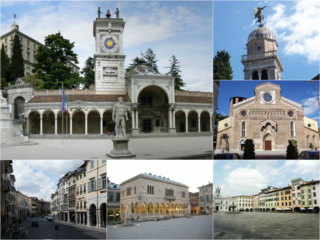
Udine is a city and comune (municipality) in north-eastern Italy, in the middle of the Friuli Venezia Giulia region, between the Adriatic Sea and the Carnic Alps. It is the capital of the Regional decentralization entity of Udine. Its population was 100,514 in 2012, 176,000 with the urban area.

Thiene is a city and comune in the province of Vicenza, in northern Italy, located approximately 75 kilometres (47 mi) west of Venice and 200 kilometres (120 mi) east of Milan. The city has an active and lively industrial sector, composed mainly of small to medium-sized companies.

Bracciano is a small town in the Italian region of Lazio, 30 kilometres northwest of Rome. The town is famous for its volcanic lake and for a particularly well-preserved medieval castle Castello Orsini-Odescalchi. The lake is widely used for sailing and is popular with tourists; the castle has hosted a number of events, especially weddings of actors and singers.
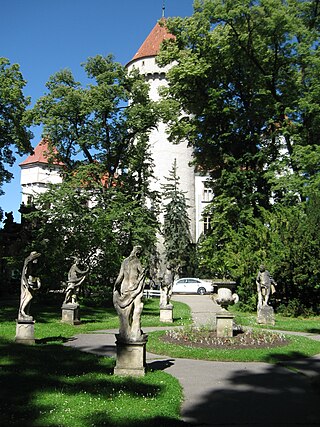
Konopiště Castle is a four-winged, three-storey castle located in Konopiště, now a part of the town of Benešov in Central Bohemian Region, Czech Republic. It has become famous as the last residence of Archduke Franz Ferdinand of Austria, heir to the Austro-Hungarian throne, whose assassination in Sarajevo triggered World War I. The bullet that killed him, fired by Gavrilo Princip, is now an exhibit at the castle's remote museum.

Albino is a comune in the province of Bergamo, in Lombardy, northern Italy. It is located northeast of Bergamo and is situated in the valley of the river Serio. The comune is included in the perimeter of the Alpine Convention international treaty.

The Castello Sforzesco is a medieval fortification located in Milan, Northern Italy. It was built in the 15th century by Francesco Sforza, Duke of Milan, on the remnants of a 14th-century fortification. Later renovated and enlarged, in the 16th and 17th centuries it was one of the largest citadels in Europe. Extensively rebuilt by Luca Beltrami in 1891–1905, it now houses several of the city's museums and art collections.

Battaglia Terme is a town and comune in the Veneto region of Italy, in the province of Padua.

Palazzo Schifanoia is a Renaissance palace in Ferrara, Emilia-Romagna (Italy) built for the Este family. The name "Schifanoia" is thought to originate from "schivar la noia" meaning literally to "escape from boredom" which describes accurately the original intention of the palazzo and the other villas in close proximity where the Este court relaxed. The highlights of its decorations are the allegorical frescoes with details in tempera by or after Francesco del Cossa and Cosmè Tura, executed ca 1469–70, a unique survival of their time.
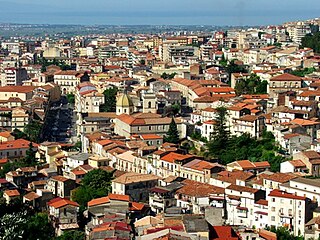
Lamezia Terme, commonly called Lamezia, is an Italian city and comune of 70,452 inhabitants (2013), in the province of Catanzaro in the Calabria region.

The Palazzo Ducale di Mantova is a group of buildings in Mantua, Lombardy, northern Italy, built between the 14th and the 17th century mainly by the noble family of Gonzaga as their royal residence in the capital of their Duchy. The buildings are connected by corridors and galleries and are enriched by inner courts and wide gardens. The complex includes some 500 rooms and occupies an area of c. 34,000 m2, which make it the sixth largest palace in Europe after the palaces of the Vatican, the Louvre Palace, the Palace of Versailles, the Royal Palace of Caserta and the Castle of Fontainebleau. It has more than 500 rooms and contains seven gardens and eight courtyards. Although most famous for Mantegna's frescos in the Camera degli Sposi, they have many other very significant architectural and painted elements.
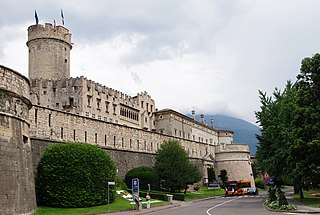
Buonconsiglio Castle is a castle in Trento, northern Italy.
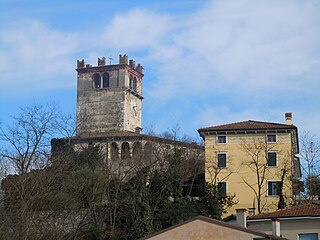
Castelnuovo del Garda is an Italian comune (municipality), in the Province of Verona, in Veneto, on a couple of morainic hills few kilometers south-east from Lake Garda. Verona is about 20 km to the east, Venice is 140 km east and Milan 140 km west.
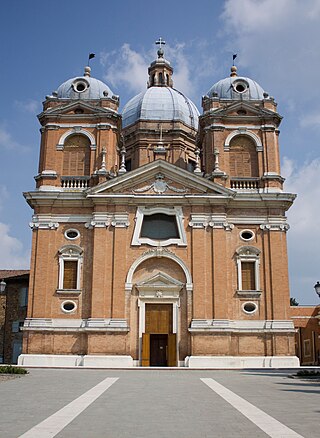
Fiorano Modenese is a comune (municipality) in the province of Modena in the Italian region Emilia-Romagna, located about 45 kilometres (28 mi) west of Bologna and about 15 kilometres (9 mi) southwest of Modena. Neighboring municipalities are Formigine, Sassuolo, Serramazzoni, Maranello.

Villa Molin is a patrician residence in the neighborhood of Mandria, in Ponte della Cagna, south of Padua, in the Veneto region of northern Italy. It was designed for Nicolò Molin, a Venetian noble, by Vincenzo Scamozzi and completed in 1597. It faces Mandriola, on the opposite side of the Canale di Battaglia. The original agricultural setting of the villa, composed of pasture and orchards, has given way to a residential dormitory community of Padua.

Giovanni Battista Zelotti was an Italian painter of the late Renaissance, active in Venice and her mainland territories.
Giovanni Antinori was an Italian neoclassical architect. Employed by the papacy, he oversaw the re-erecting of three of Rome's obelisks - the Quirinale, the Sallustian and the Montecitorio.
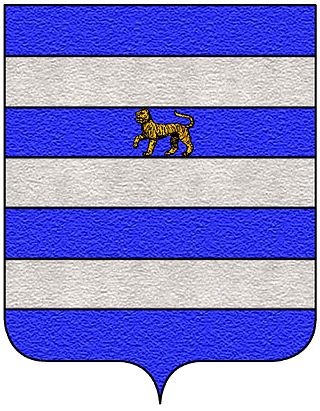
The House of Obizzi, which claimed descent from the Frankish Counts of Burgundy, was a prominent Italian noble family of Padua, who amassed great political power and wealth as feudatories of the Este, and is noted as early as the eleventh century. The Marquesses "degli Obizzi del Catajo", ending with the death in 1805 of marquess Tommaso degli Obizzi, were the heads of the great Guelf family.

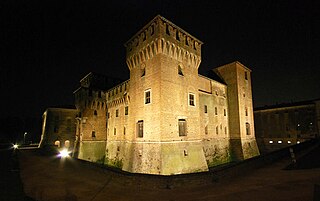
The Castello di San Giorgio is part of the Ducal palace of Mantua. It is a moated rectangular castle, each of which's four corners has a large tower and the moat is crossed by three drawbridges.